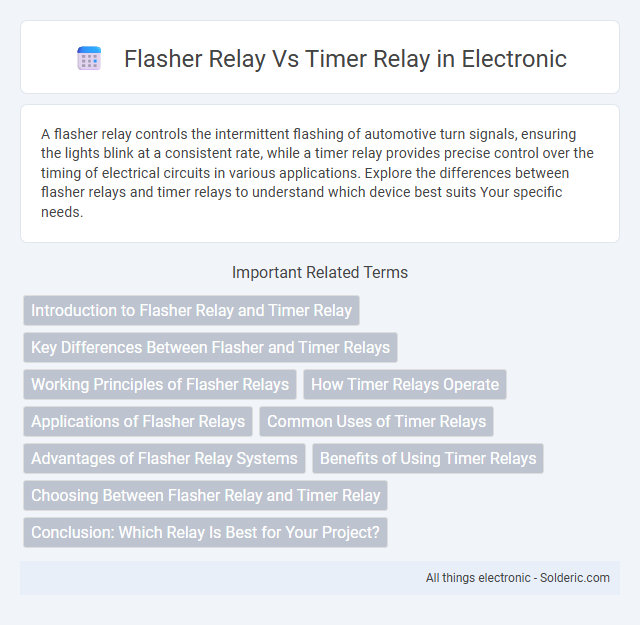A flasher relay controls the intermittent flashing of automotive turn signals, ensuring the lights blink at a consistent rate, while a timer relay provides precise control over the timing of electrical circuits in various applications. Explore the differences between flasher relays and timer relays to understand which device best suits Your specific needs.
Comparison Table
| Feature | Flasher Relay | Timer Relay |
|---|---|---|
| Function | Generates blinking or flashing signals | Controls delay timing for ON/OFF operations |
| Application | Turn signals, indicator lights | Delay circuits, sequential control |
| Operation Type | Periodic ON/OFF switching automatically | Time-delayed switching based on set intervals |
| Timing Adjustment | Fixed or adjustable flash rate | Customizable delay time (seconds to hours) |
| Output | Flashing pulses | Steady ON/OFF after delay |
| Typical Use Cases | Vehicle indicators, emergency signals | Industrial automation, lighting control |
| Complexity | Simple electronic/mechanical design | More complex with programmable options |
Introduction to Flasher Relay and Timer Relay
Flasher relays are electromechanical or electronic devices used to control the intermittent operation of vehicle turn signals and hazard lights, providing a consistent blinking pattern. Timer relays, on the other hand, are specialized control devices designed to delay the activation or deactivation of electrical circuits according to preset time intervals, commonly utilized in automation and industrial applications. Both relays optimize circuit control by managing timing functions but differ significantly in purpose and application scope.
Key Differences Between Flasher and Timer Relays
Flasher relays are designed to create intermittent on-off signals primarily used in automotive turn signals and warning lights, providing a simple blinking function. Timer relays offer precise control over time delays and intervals in various industrial automation processes, enabling complex timing sequences. The key differences lie in their application scope, with flasher relays focusing on repetitive flashing and timer relays emphasizing customizable timing control.
Working Principles of Flasher Relays
Flasher relays operate by intermittently opening and closing electrical circuits to create a blinking effect, commonly used in automotive turn signal systems. They rely on thermal or electronic mechanisms to regulate the timing of the on-off cycles, ensuring consistent light flashes. This cyclical switching is driven by heating elements or semiconductor components that control the relay contacts based on current flow and time intervals.
How Timer Relays Operate
Timer relays operate by controlling electrical circuits based on preset time delays, allowing devices to turn on or off after a specific interval. Unlike flasher relays that continuously switch signals on and off, timer relays provide precise timing control for applications such as motor start delays and lighting control. Your system benefits from enhanced automation and energy efficiency with the accurate timing functions of timer relays.
Applications of Flasher Relays
Flasher relays are primarily used in automotive lighting systems to control the blinking of turn signals and hazard lights, ensuring consistent and reliable flashing patterns. They are also employed in warning and indicator circuits, such as emergency vehicle lights and industrial signal lamps, to provide visual alerts. Their simple design and ability to operate under varying voltage conditions make flasher relays ideal for applications requiring rhythmic on-off signaling.
Common Uses of Timer Relays
Timer relays are commonly used in industrial automation to control the operation of machinery by providing precise timing functions such as delay on/off, interval timing, and cyclic timing. They are essential in processes like conveyor belt control, lighting systems, motor starters, and HVAC systems to ensure operations occur at designated times. Unlike flasher relays that primarily handle blinking signals in automotive and signaling applications, timer relays provide versatile timing control for complex automation tasks.
Advantages of Flasher Relay Systems
Flasher relay systems offer the advantage of simple, reliable operation with minimal wiring complexity, making them ideal for automotive and signaling applications. They provide consistent flashing rates regardless of load variations, enhancing signal visibility and safety. Your choice of a flasher relay ensures energy efficiency and easy maintenance compared to timer relay systems.
Benefits of Using Timer Relays
Timer relays offer precise control over electrical circuits by allowing you to set accurate time delays, which improves the automation and efficiency of various systems. They enhance safety by preventing premature or unintended activation of devices, reducing wear and energy consumption. Your projects benefit from increased reliability and flexibility, as timer relays can be easily programmed for multiple timing functions and integrated into complex control setups.
Choosing Between Flasher Relay and Timer Relay
Choosing between a flasher relay and a timer relay depends primarily on the application requirements for timing and signal control. Flasher relays are ideal for automotive turn signals and hazard lights, providing intermittent on-off cycling without complex timing adjustments, while timer relays offer precise control over delay and duration in industrial automation and lighting systems. Selecting the appropriate relay involves evaluating factors such as load type, timing accuracy, and operational complexity to ensure optimal performance.
Conclusion: Which Relay Is Best for Your Project?
Choosing between a flasher relay and a timer relay depends on your project's specific needs for timing precision and functionality. Flasher relays excel in applications requiring repetitive on-off cycles, such as automotive indicators, while timer relays provide adjustable, continuous timing control ideal for automation and industrial equipment. For projects demanding precise, customizable timing sequences, a timer relay is best, whereas flasher relays suit simpler, cyclical signaling tasks.
Flasher Relay vs Timer Relay Infographic

 solderic.com
solderic.com